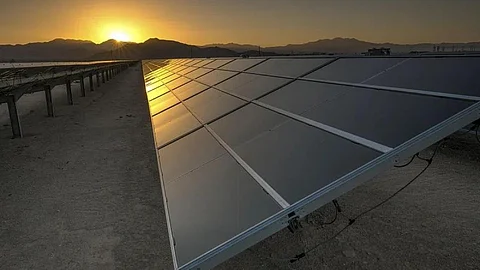
- Topics
- Feature
- Opportunities & Events
- Data
- Hindi Portal
- Topics
- Feature
- Opportunities & Events
- Data
- Hindi Portal

To meet its commitments under the Paris Agreement, India must install an additional 300 GW of utility-scale solar and wind energy by 2030, with the goal of achieving net-zero emissions by 2070. However, the land-intensive nature of renewable energy poses environmental and social challenges that need to be responsibly managed.
This was the consensus among experts who congregated in New Delhi for a discussion on addressing land-use challenges to deploy renewable energy in India.
Organised by The Nature Conservancy (TNC), in partnership with Vasudha Foundation and National Solar Energy Federation of India (NSEFI), the event on ‘Addressing Land-Use Challenges and Accelerating Renewable Energy Development in India’ brought together government officials, investors, developers, and policy experts to address the critical issue of socio-ecological conflicts hindering the rapid deployment of renewable energy in India.
Dr. Annapurna Vancheswaran, Managing Director of TNC India, while inaugurating the roundtable, remarked, “To meet the Paris Agreement commitments, India needs to install ~10 to 15 times more solar and wind energy capacity than the stated 2030 target if it is to achieve net-zero by 2070. Therefore, acquiring land for renewable energy deployment is one of the biggest challenges for India due to socio-ecological conflicts. Also, interlinkages between land and energy production while drafting integrated development policies must be studied and deliberated on. The land-intensive nature of renewable energy can also have environmental and social impacts if not planned responsibly.”
In India, concerns persist regarding the competition for land between large-scale renewable energy facilities and other uses such as ecological conservation, food production, grazing, and human habitation.
“The SiteRight tool has the ability to answer many unanswered questions that plague the community and renewable energy developers in India, leading to conflicts, especially in a scenario where land is scarce for deploying renewable energy projects. The tool emerges as a powerful solution in this regard, and we are excited to work in conjunction with TNC India to demonstrate the remarkable benefits it can bring to India," said Dr Ajay Mathur, Director General, International Solar Alliance (ISA) during the Roundtable, referring to screening and siting decision support tool.
Repurposing former mined-out lands is another crucial aspect of this transition. By 2030, over 2500 square kilometres of coal mine lands and associated infrastructure will be available for repurposing. Developing renewable energy on closed mining lands can generate revenue, create jobs, reduce decommissioning costs, enhance energy security, and provide economic value to post-mining communities. The availability of power transmission infrastructure and extensive land further support this development.
“Mined lands are significant in size and therefore, optimal for utility scale renewable energy projects. We’re working with TNC to repurpose some of our mined-out lands for solar projects since there isn’t much potential for wind project there," said Dr Suresh Chandra Suman, Director, Mines and Finance, Neyveli Lignite Corporation, which has deployed TNC’s SiteRight tool to identify lands fit for potential renewable energy projects.
“To attain true sustainability of the renewable energy ecosystem, there is also a need to round off contributions from states whose renewable energy uptake hitherto has been limited," added Mr Deepak Gupta, Director General, National Solar Energy Federation of India (NSEFI) during the conference.
Various studies indicate that achieving net-zero emissions by 2070 requires solar and wind capacities of approximately 4000 to 5000 GW by 2050 and 5500 to 7400 GW by 2070. To attract investment, India's renewable energy ecosystem needs to ensure developers have the necessary security and confidence, including addressing the challenge of identifying land parcels free of social and environmental conflicts for new renewable energy infrastructure installation.
The roundtable saw presence of renewable energy experts including Alok Nigam, Head, UPC Renewables, Amarnath N, CEO, Karnataka Solar Power Development Corporation Ltd., Anil Dhaka, MD, Rajasthan Renewable Energy Corporation Limited, , Dilip Nigam, Advisor, Ministry of New and Renewable Energy, GoI, Martand Shardul, Policy Director, Global Wind Energy Council, India, Mohit Bhargava, CEO, NTPC Renewable Energy Ltd., and NTPC Vidyut Vyapar Nigam Ltd., Pankaj Batra, Senior Advisor, IRADe, and R Venkatraman, Co-founder and CTO, H-Nu Energy.
Renewable energy projects need to be sited responsibly and smartly to avoid land conflicts, associated project delays, higher risks, and costs. The Nature Conservancy (TNC), Vasudha Foundation (VF), Center for Science, Technology, and Policy (CSTEP), and Foundation for Ecological Security (FES) have collaborated to create a tool—SiteRight—to help decision makers make better siting choices.
The SiteRight tool identifies areas where solar and wind development is less likely to encounter socio-ecological conflicts, thereby helping to reduce project delays and cost overruns.
SiteRight uses the best available information to support early screening and inform siting decisions. It should be one of the sources of information to be considered when making siting decisions. The tool is not intended to replace the need for a site-level assessment of impacts or consult relevant agencies before making siting decisions.